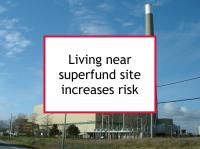Most studies concerning environmental risk factors for breast cancer have focused on air pollution. These studies have identified a number of airborne carcinogens as breast cancer risk factors, including benzene, benzoApyrene (BaP), heavy metals such as cadmium, polychlorinated biphenyls (PCBs), polycyclic aromatic hydrocarbons (PAHs), propylene dichloride, and trichloroethylene.
The harmful effects of such exposure appear to be both additive and synergistic. Many of the same chemicals are also present in superfund and harmful waste sites. Contaminants from such sites may impact nearby residents through groundwater and soil contamination in addition to airborne releases. Now a new study has identified proximity to a superfund site as a risk factor for metastatic breast cancer at initial presentation.
Latest research links superfund proximity to initial stage IV
The study referenced above was designed to evaluate the association between National Priorities List (NPL) superfund site proximity and stage IV metastatic breast cancer at diagnosis. To conduct the study, the authors used the Florida Cancer Data System to identify breast cancer cases diagnosed from 2015 to 2019 among women having valid census tract identification numbers. Census tracts in Florida are subdivisions within counties with populations of approximately 4,000. A census-designated place of residence is a geographic area defined by the U.S. Census Bureau to represent named concentrations of population in Florida. NPL proximity was defined as at least one NPL site within the census-designated place of residence of study participants.
A total of 21,505 breast cancer cases with average age 62 ± 14 years were included in the study. Participants identified as white (79%) and non-Hispanic (63%), Hispanic (37%), or black (18%) and 93.6% had non-metastatic disease upon diagnosis. The initial analysis was adjusted for age, race, ethnicity, and type of insurance. The 10.1% of participants who lived in census-designated places with at least one superfund site experienced 29% higher likelihood of metastatic presentation than earlier stage disease. A 27% higher likelihood of metastatic disease was still found after additional adjustment for median income. Metastatic presentation is a mark of tumor aggressiveness.
The authors conclude that living near at least one NPL superfund site is associated with nearly 30% higher likelihood of metastatic rather than non-metastatic breast cancer at initial presentation. In another paper using similar data, the authors also reported that the combination of proximity to an NPL site and having high exposure to airborne particles up to 2.5 microns in diameter (PM2.5) was associated with higher likelihood of triple negative breast cancer. Both findings suggest a role for environmental exposures in breast cancer development, implying that pollutants influence tumor biology and aggressiveness. Further research is warranted to validate the findings and determine the underlying mechanisms, according to the authors.
Please see our air pollution tag for more information.
